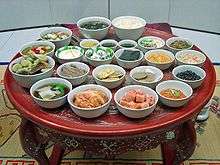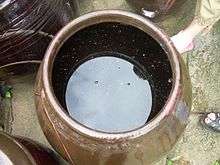Soup soy sauce
 |
| This article is part of a series on |
| Korean cuisine 한국 요리 조선 료리 |
|---|
|
|
Soup soy sauce is a type of Korean soy sauce (ganjang) made entirely of fermented soybean(meju) and brine. It is also a byproduct of doenjang production. Both lighter in colour and saltier than other Korean ganjang varieties, soup soy sauce is used mainly in guk(soup) and namul(seasoned vegetable dish) in modern Korean cuisine.[1]
Names
Soup soy sauce is called by many different names due to its complicated status changes in relation with other types of Korean soy sauces. In English speaking world, it is most commonly known as soup soy sauce,[2] which is a direct translation of guk-ganjang.
- Hansik ganjang (Korean: 한식 간장) – "Korean-style soy sauce" is a name used by Korean Ministry of Food and Drug Safety.[3][4]
- Jaeraesik ganjang (Korean: 재래식 간장) – "traditional soy sauce" is a named used for soup soy sauce when compared to gaeryang ganjang(Korean: 개량 간장, "modernized soy sauce"), which is now the most widely used (and considered "regular") type of soy sauce in modern Korean cuisine.
- Joseon-ganjang (Korean: 조선간장) – "Joseon soy sauce" is a name used for soup soy sauce, when compared to Wae-ganjang (Korean: 왜간장, "Wae soy sauce"). The term Wae soy sauce is used to refer to modernized gaeryang ganjang, which was introduced to Korea during the era of Japanese forced occupation.
- Guk-ganjang (Korean: 국간장) – The name "soup soy sauce" is used because in modern Korean cuisine it is used mainly for soup. Also, it is the name used by many popular soy sauce brands such as Sempio, Chung Jung One (Daesang), and Beksul (CJ Cheil Jedang).
- Jip-ganjang (Korean: 집간장) – "home soy sauce" is a name used for homebrewed soup soy sauce.
History
The earliest soy sauce brewing in Korea seem to have begun prior to the era of the Three Kingdoms.[5] The Records of the Three Kingdoms, a Chinese historical text written and published in the 3rd century, mentions that "Goguryeo people are good at brewing fermented soy beans." in the section named Dongyi (Eastern foreigners), in the Book of Wei.[6][7] Jangdoks used for soy sauce brewing are found in the mural paintings of Anak Tomb No.3 from the 4th century Goguryeo.[8]
In Samguk Sagi, a historical record of the Three Kingdoms era, it is written that ganjang and doenjang along with meju and jeotgal were prepared for the wedding ceremony of the King Sinmun in February 683.[9] Sikhwaji, a section from Goryeosa (History of Goryeo), recorded that ganjang and doenjang were included in the relief supplies in 1018, after a Khitan invasion, and in 1052, when a famine occurred.[10] Joseon texts such as Guhwangchwaryo and Jeungbo sallim gyeongje contain the detailed procedures on how to brew good quality ganjang and doenjang.[5] Gyuhap chongseo explains how to pick a date for brewing, what to forbear, and how to keep and preserve ganjang and doenjang.[9]
Production

Soup soy sauce is made entirely of fermented soybean and brine. The brewing process also produces doenjang(Korean fermented bean paste).
Meju, Korean soybean brick, is made around ipdong in early November. Soybeans are soaked overnight, boiled in salt water, and then pounded in a mortar(jeolgu). About a doe(≈1.8 litres) or two does of pounded soybean is chunked, compressed, and shaped into a cube or a sphere called meju. The meju bricks are then dried in a cool shaded area for a week to several weeks until firm. When the bricks harden, they are tied with rice straws to the eave of the house, or put in the warm ondol room with rice straws, for fermentation. In jeongwol, the first month of the Lunar year, well fermented meju bricks are washed and sun-dried.
After drying, the meju bricks are aged in onggi crocks(jangdok) with brine. Charcoal and chillies are added for their adsorbent and antibacterial properties, as well as folk-religious beliefs that they drive evil spirits away. As the fermentation progresses, brine acquires flavour and colour. This aged brine is boiled to become soy sauce(soup soy sauce), and the rest (aged meju chunks) are mashed to become soybean paste(doenjang).
Types
Korean Ministry of Food and Drug Safety's Food Code classifies hansik ganjang into two categories by their ingredients.[3][4]
- Jaerae-hansik-ganjang (Korean: 재래한식간장, "traditional Korean-style soy sauce") – soy sauce made with traditional style meju and brine.
- Gaeryang-hansik-ganjang (Korean: 개량한식간장, "modernized Korean-style soy sauce") – soy sauce made with non-traditional meju (which can be made of regular soybean, rice, barley, wheat or degreased soybean, and ripened using traditional method or aspergillus) and saline solution.
Depending on the length of aging, hansik ganjang can be divided into three main varieties: clear, middle, and dark.
- Haet-ganjang(Korean: 햇간장, "new soy sauce") – soy sauce aged for a year. Also called cheongjang(Korean: 청장(淸醬), "clear soy sauce").
- Jung-ganjang(Korean: 중간장, "middle soy sauce") – soy sauce aged for three to four years.
- Jin-ganjang(Korean: 진간장(津간醬), "dark soy sauce") – soy sauce aged for more than five years. Also called jinjang(Korean: 진장(陳醬), "aged soy sauce"), nongjang(Korean: 농장(濃醬), "thick soy sauce"), or jingamjang(Korean: 진감장(陣甘醬), "aged mature soy sauce").
References
- ↑ 정, 재균 (4 April 2014). "양조간장·진간장·국간장 무슨 차이지? 간장의 종류별 활용법" [Yangjo-ganjang, jin-ganjang, and guk-ganjang: What's the difference? Uses of different types of ganjang.]. Chosun Ilbo (in Korean). Retrieved 9 November 2016.
- ↑ Tam, Ruth (31 August 2015). "How it feels when white people shame your culture's food — then make it trendy". The Washington Post. Retrieved 9 November 2016.
- 1 2 "Food_Code(No.2015-4_20150203)". www.mfds.go.kr. MFDS - Ministry Of Food And Drug Safety. 3 February 2015. Retrieved 9 November 2016.
- 1 2 "식품공전 (제 5. 식품별 기준 및 규격 / 20. 장류)" [Food Code (Article 5. Standards and Specifications for Each Food Product / 20. Soy Sauces or Pastes)]. www.foodsafetykorea.go.kr (in Korean). 식품의약품안전처 식품안전정보포털. 30 September 2016. Retrieved 9 November 2016.
- 1 2 강, 명기 (20 October 2006). "항암효과가 탁월한 우리의 구수한 된장" [Our flavourful doenjang with potent antitumor effect]. Dailian (in Korean). Retrieved 9 November 2016.
- ↑ 황, 광해 (9 January 2013). "바람이 말리고 세월이 삭힌 깊은 맛" [Deep flavour, dried by wind and fermented by time]. Weekly Hankook (in Korean). Retrieved 9 November 2016.
- ↑ Koo, Chun-Sur (Spring 2004). "Ganjang and Doenjang: Traditional Fermented Seasonings" (PDF). Koreana. 18 (1). The Korea Foundation. Retrieved 9 November 2016.
- ↑ 신, 동민 (9 November 2015). "행복을 부르는 맛 '간장'…집에서 만든 만능간장소스 하나면 OK" [Ganjang, the flavour that brings happiness... Home-made versatile ganjang sauce is all you need]. Maekyung Economy (1831). Retrieved 9 November 2016.
- 1 2 하, 상도 (11 January 2016). "신라시대에 왕비 폐백품목에도 있었던 식품은?" [Guess what food was used for pyebaek ceremony of a Silla queen]. Chosun pub (in Korean). Retrieved 9 November 2016.
- ↑ 김, 성윤 (19 January 2012). "정월에 담근 장이 가장 맛있다는데…" [Jang tastes the best when made in the first month of the year (in the Lunar calendar)]. Chosun Ilbo (in Korean). Retrieved 9 November 2016.
